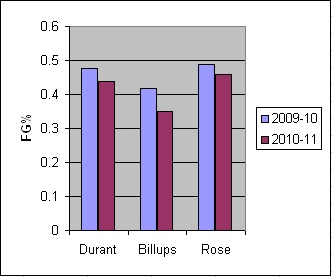Three NBA players from the US team were in the top-100 in minutes per game in last summer's FIBA tournament. The players were Kevin Durant, Chauncey Billups, and Derrick Rose. Here is a look at their FG shooting percentages:
There might be a potential trend here, but we need more data. Let's turn to players in the FIBA tourney from other countries. For purposes of investigating tired legs in the NBA, it seems reasonable to limit the study to players who participated in at least half of their team's NBA games, both last season and this season. Bench warmers and players who don't play due to injury won't be susceptible to the same types of fatigue. Players such as Hamed Haddadi, Carlos Delfino, and Paddy Mills get eliminated at this stage. The international players who were in the top-100 in minutes played per game at FIBA and who have played in at least half their team's NBA games in each of the last two seasons, along with their FG percentages for each of the past two seasons:

If we look at the paired data for the two years from these 17 players, we can perform a hypothesis test on the differences. In other words, the test will indicate whether it is reasonable to assume that the FG% numbers for both seasons are the same or if they are somehow different. To get each difference, take the FG% from 09-10 and subtract the corresponding FG% for 10-11. Based upon the order of the subtraction, the results will be positive numbers, except for Diaw, Barbosa, and Gasol. A normal probability plot indicates that it is reasonable to assume that the data are normally distributed. If the paired t-test is applied to the data, the results are a test statistic of t = 3.497 from a distribution with 16 degrees of freedom and a p-value of p = 0.003409. With a p-value as small as the one given here, even at a 1% significance level, there is evidence to indicate that these FG% numbers for the two years are not the same. It is a virtual certainty. For the players that participated in FIFA, it is a safe bet to conclude that the FG% numbers are not the same (i.e., lower) this year when compared with last year.




No comments:
Post a Comment